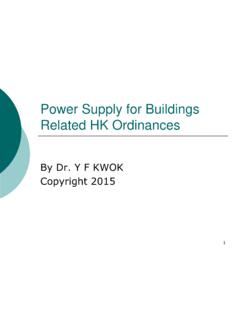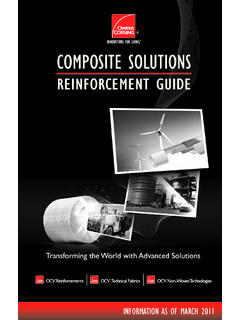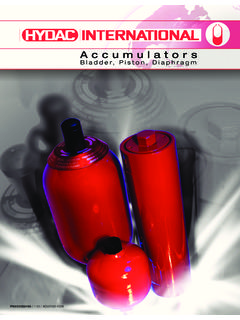Transcription of mebs6000 0809 03 cold and hot water design - ibse.hk
1 mebs6000 Utility Sam C M HuiDepartment of Mechanical EngineeringThe University of Hong KongE-mail: of cold and Hot water SystemsFeb 2009 Contents design principles water demand water storage Pipe sizing Pipe materials Pump systems Other considerationsDesign principles Common water supply systems cold water system Potable/fresh water Flushing (salt water in HK) Cleansing water Fire service Swimming pool filtration Irrigation ( for landscape) Fountain circulation Air-conditioning water , etc. Hot water system ( in hotels & hospitals)We will focus on theseDesign principles Major tasks of water systems design : 1.
2 Assessment & estimation of demands 2. Supply scheme & schematic 3. water storage requirements 4. Piping layout 5. Pipe sizing 6. Pump system design The systems must comply with water Authority (WSD) requirementsDesign principles General principles for installing plumbing works (from WSD Plumbing Installation Handbook) All water fittings and pipework shall comply with the relevant Waterworks Regulations All plumbing works shall be carried out in accordance with the Hong Kong Waterworks Requirements All plumbing works shall be carried out by a licensed plumber System main pipes should preferably not be run through the individual premises Also, Building (Standards of Sanitary Fitments, Plumbing, Drainage Works and Latrine) RegulationsDesign principles Plumbing proposal (vetted by WSD) A block plan in a scale of 1.
3 1000 showing the location and boundary of the development The locations should be marked with datum level A plan showing the alignment and size of the proposed connection pipes from the main to the development A plan showing the proposed alignment and size of the internal underground water pipes to be laid in the development Vertical plumbing line diagrams(Source: )Example of a plumbing system schematic (fresh & flushing water supplies)(Source: )Example of plumbing layout designDesign principles Plumbing proposal (cont d) A schedule containing the following items :- (a) number of flats/units in each block of the building (b) address of each premise needs individually metered water supply (c) number of draw-off points and sanitary fittings in each unit (d) estimated daily consumption for all trade purposes Meters arranged in meter rooms & fittings at the meter positions The relevant standards for the pipe materials to be used Capacities of the water storage tanks roof storage tanksWater demand water demanddepends on.
4 Type of building & its function Number of occupants, permanent or transitional Requirement for fire protection systems Landscape & water features Typical appliances using the cold water WC cistern, wash basin, bath, shower, sink Washing machine, dishwasher Urinal flushing cisternWater demand Theoretical framework: Probability Theory Based on statistics & a binomial distribution Pm= probability of occurrence; nis the total number of fittings having the same probability and mis number of fitting in use at any one time Probability factor of a particular no. of draw off s occurring at any one time is: P = (t time of appliance filling) / (T time between successive usage of the appliance)mnmmPPmnmnP =)1()!
5 (!!(Source: IOP, 2002. Plumbing Engineering Services design Guide)Probability graphExample:If 100 appliances each take 30 sec to be filled, and are used at 1200 sec (20 min) frequency interval, then:P = t / T= 30/1200= the graph, out of 100 appliances, only 7 would be in use at any one demand Simultaneous demand Most fittings are used only at irregular intervals It is unlikely that all the appliances will be used simultaneously No need to size pipework on continuous max. Key factors to consider: Capacity of appliance (litres) Draw-off flow rate (l/s) Draw-off period, or time taken to fill appliance (sec) Use frequency, time between each use (sec) water demand Loading Unit ( ))
6 A factor given to an appliance relating the flow rate at its terminal fitting to Length of time in use Frequency of use for a particular type Use of building Evaluate the probablemaximum Relates the flow rate to the probable usage Also, consider design & minimumflow ratesDesign flow rates and loading per positionUrinal flushing hot or coldWashing machine size DN per tapSpray tap or spray hot or coldShower head (will vary with type of head) tap, 1-DN per WCWC trough flow rate (l/s) tap, -DN tap, -DN tap, -DN per tapBidetDesign flow rate (l/s) size DN per tapWash basin tap size -DN flushing cistern single or dual flush (to fill in 2 min.)
7 Outlet fitting(Source: Garrett, R. H., 2008. Hot and cold water Supply) water demand Apply probability theory, with caution Assume random usage with fittings (is this true?) Determine max. frequencies of use Estimate average water usage rates & time The theory is valid with large nos. of fittings Often expect to be exceeded at 1% time only Reliability and risk management (what is the consequence) Need to understand the context/circumstance Is it similar to average/typical? (* adjust data if needed) Any foreseeable special requirements? water demand design flow considerations A small increase in demand over design level will cause a slight reduction in pressure/flow (unlikely to be noticed by users) Exceptional cases, such as.
8 Cleaners sinks (depends on one s behaviour) Urinal flushing cisterns (constant small flow) Team changing rooms at sport clubs (high demand) Special events (ad hoc demand) water storage Purposes of water storage Provide for an interruption of supply Accommodate peak demand Provide a pressure (head) for gravity supplies design factors Type and number of fittings Frequency and pattern of use Likelihood and frequency of breakdown of supply (often design for 12- or 24-hour reserve capacity)Recommended minimum storage of cold and hot water systems45 per bed space135 per bed spaceNursing or convalescent per meal7 per mealRestaurant45 per bed space120 per bed spaceNurses home25 per bed space135 per bed spaceChildren s home or residential nursery23 per per per per per employee45 per bed space32 per bed spaceMinimum hot water storage (litres)200 per bed spaceHotel90 per pupil15 per pupil20 per pupil45 per employee40 per employee90 per bed spaceMinimum cold water storage (litres)Boarding schoolDay school:- nursery or primary- secondary or technicalOffice premises.
9 - with canteen facilities- without canteen facilitiesHostelType of building(Source: Garrett, R. H., 2008. Hot and cold water Supply)Note: Minimum cold water storage shown includes that used to supply hot water of cold water storage per occupant7 Restaurant (* per meal)45 Offices with canteens90 Schools, boarding35 Offices without canteens135 Houses and flats135 Hotels90 Hostels45 Hospitals, per staff on dutyStorage per occupant (litres)30 Schools, day135 Hospitals, per bed10 Factories (no process)Type of building(Source: )Estimation of hot water consumption2520115 Schools, boarding5922 Offices304590 160 Houses and flats304590 160 Hotels304590 Hostels2722110 Hospitals, mental9309 Peak demand per occupant (litres/hr)Storage per occupant (litres)Consumption per occupant (litres/day)515 Schools, day27160 Hospitals, general522 45 Factories (no process)Type of building(Source.)
10 Fixtures water requirements (demand at individual water outlets)11056 Urinal flush valve5519 Shower head5510 Lavatory faucet, self faucet, supply pressure (kPa)132 water closet with flush valve23 Sink 3/4"17 Sink 3/8", 1/2"10 Shower, temperature controlledFlow rate (litres/min)10 water closet with gravity tank15 Laundry machine 19 Bathtub faucetType of fixture(Source: )Fixtures, cold water storage, hot water consumption & flow water flow rate (litre/s)4590 Basin (public)------45 90180---90 18014 Hot water consumption (litre/hr)180 Urinal90 Sink450 900 Shower180 Garden water tapCold water storage capacity (litres)180WC900 Bath90 Basin (private)Type of fixture(Source.)









